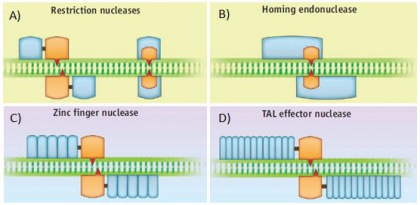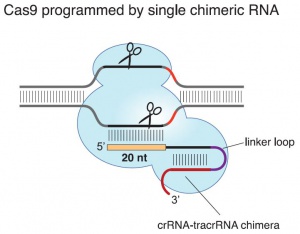CH391L/S14/CRISPR
Contents |
Background
Decades ago, the discovery of nucleases, enzymes that cut DNA, opened the door to DNA editing. While exonucleases cleave terminal nucleotides of a DNA strand, endonucleases cleave within a DNA strand and these can do so randomly, structure-specific or at precise short DNA sequences. Breakthroughs in our ability to edit genes have come in the form of techniques with better specificity, which means the targeting of a genomic sequence while excluding cleavage at other sites. Zinc finger nucleases (ZFNs), transcription activator-like effector nucleases (TALENs) and homing meganucleases can be programmed to cleave at a specific genomic site, but these can be costly and challenging to make.
CRISPR/Cas system
In 2007, it was discovered that certain bacteria had a defense system that combined short RNA guide oligonucleotides – virus or plasmid derived - with endonucleases. It was called the CRISPR/Cas system and it is an RNA-guided endonuclease that allows the cell to recognize and cleave DNA that it has previously encountered. It works as an adaptive immune system that protects a bacteria against invading DNA. Not much after its discovery, CRISPR/Cas systems in combination with recombination techniques were successfully used to modify genes in prokaryotes and plants. Very recently CRISPR/Cas gene editing has been shown to work even in human cells. The unprecedented versatility of the CRISPR/Cas system has empowered scientist with an easily programmable and surgically precise DNA editing tool.
How the CRISPR/Cas system works
CRISPR stands for Clustered Regularly Inter-Spaced Palindromic Repeats, and these are genomic regions where prokaryotes are known to retain the footprint - sequence fragments - of previous encounters with virus or plasmid DNA. The way it works in nature is that any newly encountered invader that the bacteria survives gets cleaved and fragments from the foreign DNA (called spacers) get incorporated between short repeat sequences in CRISPR regions. The CRISPR loci are transcribed to produce CRISPR RNA (crRNA), containing diverse repeat-spacer sequences which then are processed to separately become part of a CRISPR/Cas complex.
This processing requires the binding of trans-activating crRNAs (tracrRNAs) to the repeat sequences in the freshly transcribed long CRISPR’s transcript, triggering the transcript to be cleaved into the discrete space-repeat Cas bound sequences that make mature CRISPR/Cas complexes. The spacer that remains in the CRISPR/Cas complex becomes the RNA-guide component that binds invading DNA, allowing Cas nuclease domains to cleave at the specific target site (called protospacer).
Once a CRISPR/Cas system detects the target foreign DNA, it binds, unwinds and cuts at the precise complimentary sequence, and if it also finds the correct protospacer adjacent motif (PAM) then the target DNA, such as a virus or other mobile DNA is cleaved. Thus, in nature, the CRISPR/Cas system is essentially an adaptive bacterial defense system against viruses and foreign DNA.
There are three types of CRISPR/Cas systems, but the main difference is that type I and type III systems depend on a large multi-Cas protein complex, while on type II systems only Cas9 is responsible for crRNA-guided silencing. It is for this reason that CRISPR/Cas9 type II systems has been preferentially used given that the only thing needed to target a DNA sequence is to modify the guide crRNA.
CRISPR/Cas gene editing
CRISPR-Cas system genome editing generally involves three steps: (1) site specific double-stranded DNA break (2) activated DNA repair machinery (3) Non-homologous end joining (NHEJ) or homologous recombination (HR). NHEJ results in nucleotide insertions and deletions at the DSB site. This allows the experimenter to add designed oligonucleotides to perform gene editing at the specific site.
Advantages and Disadvantages of CRISPR/Cas editing
Advantages
- CRISPR/Cas systems are invader-specific, adaptive, and heritable.
- Easy to program targeted gene specific modifications using the CRISPR-Cas9 system, given it merely requires changing the sequence (20bp) of the guide RNA.
- Amenable to high-throughput construction of a library of targeting vectors - multiplexing.
- Works on all cell types.
Disadvantages
- Remaining offsite nuclease activity (off-target cleavage): up to six mismatches are tolerated between crRNA and target DNA.
- Efficiency: it can be improved.
iGEM
http://2013.igem.org/Team:Freiburg/Team2

